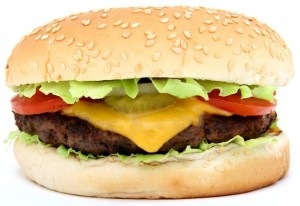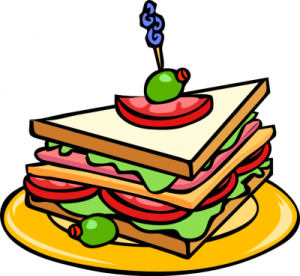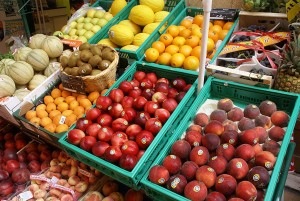I love burgers – much more than steak of any kind. So, I budget them into my food plan. Holding the bacon, cheese, and fried onions cuts down on the calories – but for occasional indulgences it’s even possible to have those – just keep a close eye on the portion size.
According to the Tufts Health & Nutrition Letter (2/10), the fight for our dollars to purchase the biggest burger is on. The trade journal, Advertising Age, is calling the marketing war for the consumer’s bucks for big or biggest burger: “Battle of the Big Burgers.”
- Bigger and biggest nutritional stats*
Applebee’s A1 Steakhouse Burger: 1085 Calories, 60g Fat, 80, Carbs, 52g Protein
Burger King Steakhouse XT: 970 Calories, 55g Carbs, other info N/A
Carl’s Jr. $6 Burger: 890 Calories, 54g Fat, 58g Carbs, 45g Protein
Chili’s Classic bacon Burger: 1140 Calories, 72g Fat, 61g Carbs, 59g Fat
Denny’s Western burger: 1160 Calories, 65g Fat, 79g Carbs, 63g Protein
Hardee’s $6 Thickburger: 950 Calories, 59g fat, 58g Carbs, 45g Protein
Krystal BA Double Bacon Cheese: 850 Calories, 59g Fat, 48g Carbs, 32g Protein
McDonald’s Angus Deluxe: 750 Calories, 39g fat, 61g Carbs, 40g Protein
Wendy’s Bacon Deluxe Triple: 1140 Calories, 71g Fat, 47g Carbs, 79g Protein
These burgers can range from 1/2 to 3/4 of most people’s usual daily caloric and fat (especially saturated fat) allowance, and I didn’t include the amount of sodium in each burger, which is equally alarming.
How to choose? Sticking to ordering an ordinary hamburger might be your best bet if you exercise caution with the caloric fatty sides (French fries, onion rings) and not sugared drinks. A McDonald’s regular burger: 250 Calories, has less calories than any other sandwich on it’s menu. Burger King’s Whopper Jr. clocks in at 370 calories.
Don’t be misled by the healthier sounding veggie burger with it’s added on toppings. Burger King’s Veggie burger has 420 calories and 16g Fat – it’s Whopper has 670 calories and 40g fat. Ruby Tuesday’s Veggie Burger chalks up 952 Calories and 53g fat and it’s Classic Cheeseburger has 1160 calories and 81g total fat.
- SocialDieter Tip
If you know that your routine, maybe for workday lunches or after your kid’s soccer game, is probably going to include a stop at a fast food or casual dining chain, arm yourself with information by checking out the chain’s website for nutrition data. Figure out ahead of time which choice is the best for you and then stick to it when you order. If you haven’t figured out your preference before hand, chains in many states are now obliged to post in the restaurant the nutritional information for their products. Bottom line: to save calories and fat, ignore the touted “big” or “biggest” burger (even if it’s the special) and order the small, ordinary burger and ask for extra onions, pickles, and other veggies.
*All data is from Tufts University Health & Nutrition Letter February 2010



